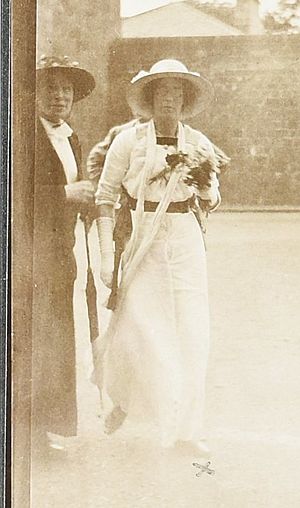Maude Edwards facts for kids
Quick facts for kids
Maude Edwards
|
|
|---|---|

Photograph of Maude Edwards, suffragette prisoner.
|
|
| Nationality | Scottish |
| Known for | Suffragette imprisoned for slashing a portrait of King George V |
Maude Edwards was a Scottish woman who believed women should have the right to vote. People who fought for this right were called suffragettes. In 1914, she was sent to Perth Prison. This happened after she damaged a painting of King George V by the artist John Lavery. The painting was displayed in the Royal Scottish Academy in Edinburgh. While in prison, Maude Edwards was force-fed, even though she had a heart condition.
Contents
Fighting for Women's Vote
Maude Edwards appeared in court in Edinburgh Sheriff Court on May 23, 1914. She was accused of damaging a painting by John Lavery. The painting was a study of King George V for a larger portrait of the Royal Family. The King himself had approved this painting.
The portrait was on display in a special room at the Royal Scottish Academy in Edinburgh. Maude Edwards, who wore thick glasses and a cloak, seemed very interested in the art. But then, in front of everyone, she used a small hatchet to strike the painting. She hit it near the King's chest, where his medals would be.
Maude Edwards took this action because Emmeline Pankhurst, another leader for women's rights, had failed to meet with the King. Mrs. Pankhurst had tried to lead a group to Buckingham Palace. Maude Edwards said it took a lot of courage to do what she did.
Since early 1913, suffragettes had been trying to get King George V to listen to their demands.
- In June 1913, Emily Davison died after being hit by the King's horse at the Epsom Derby. She was trying to draw attention to their cause.
- In October 1913, protesters interrupted the royal wedding of Princess Alexandra.
- In December 1913, a special show of Jeanne d’Arc was taken over by protesters.
Despite these actions, the King did not agree to meet with the suffragettes. By May 1914, he had become very unpopular with them. Maude Edwards' attack on the King's portrait was a strong way to show her feelings. It was a symbolic act, aimed at the King's image, to protest his refusal to support women's right to vote.
Maude Edwards' Court Case
Maude Edwards' court case was described as very lively. The court was filled with her supporters. When she entered, they cheered loudly.
When asked about the painting, Maude Edwards refused to answer. She said she would not be judged by the court. The Sheriff, who was the judge, took this as a plea of "not guilty." Her supporters applauded, and the Sheriff ordered the courtroom to be cleared. Many suffragettes had to be removed by force, cheering as they left. Grace Cadell, a doctor and suffragette, strongly resisted leaving and needed three police officers to remove her.
Maude Edwards Speaks Out
Once the court was cleared, Maude Edwards continued to speak out. She told the Sheriff that one day, people like her would be the ones judging him. She compared the court to a "Star Chamber," which was a secret court in the past. She also asked about Arabella Scott, another suffragette who was being force-fed in prison. Maude Edwards said she would keep talking all day.
When witnesses were called to speak against her, it was hard to hear them. This was because Maude Edwards kept protesting loudly. When it was her turn to present her side, she said she didn't need any witnesses. She said she was "sufficient witness in herself."
The jury decided she was responsible for damaging the painting. The Sheriff then sentenced her to three months in prison. Maude Edwards shouted that no sentence, whether three months or fifty years, would change her mind. She was first taken to Calton Gaol, but within three hours, she was moved to Perth Prison.
Time in Perth Prison
Maude Edwards arrived at Perth Prison on July 3, 1914, to begin her three-month sentence. The next day, a doctor examined her. He noted she was "somewhat hysterical." He did not pay attention to her medical certificate, which stated she had a weak heart. He believed the lady doctor who wrote it could not properly judge her condition.
Edwards began a hunger strike. She expected her heart condition would prevent her from being force-fed. However, on July 5, she was force-fed hot sweet milk and eggs through a tube. Her health was watched closely, and no bad effects were reported, so the feeding continued.
Five days later, Maude Edwards decided she had had enough. She wrote a request to be released from prison. She asked to be freed under a special law called the Cat and Mouse Act. This law allowed prisoners who were very ill from hunger strikes to be released temporarily.
In her note, she promised to stop her militant actions if she was released. She said her reason for this offer was that the prison doctor told her excitement was bad for her health. She was released from prison on July 14, 1914.
Legacy
The stories of four suffragette prisoners at Perth Prison are remembered. These women were Maude Edwards, Arabella Scott, Frances Gordon, and Frances Parker. The doctor who force-fed them was Dr. Hugh Ferguson-Watson. Their experiences were turned into a play called Cat and Mouse by Ajay Close.
See also
 In Spanish: Maude Edwards para niños
In Spanish: Maude Edwards para niños

